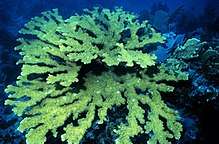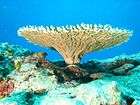Stony coral tissue loss disease
Stony coral tissue loss disease (SCTLD) is a disease of corals that first appeared off the coast of Florida in 2014. By 2019 it had spread along the Florida Keys and had appeared elsewhere in the Caribbean Sea. The disease completely destroys the soft tissue of many species of stony coral, killing them within weeks or months of becoming infected. The causal agent is unknown but is suspected to be a bacterium. The degree of susceptibility of a coral, the symptoms, and the rate of progression of the disease vary between species.[1]


History
The disease was first detected in late 2014 when a few corals off Virginia Key, in Miami-Dade County, Florida, were affected. By the following year, the disease had spread and extended from Pompano Beach to Biscayne National Park. In 2016 it reached Palm Beach County, Florida, and the upper Florida Keys, and the next year the lower Florida Keys. By August 2018, the disease had spread over 150 sq mi (388 km2) of sea, and almost half the species of coral growing in the Florida Reef Tract had been affected.[2] By January 2019 it had been reported from Jamaica, the Mexican Caribbean, Sint Maarten, and Saint Thomas, U.S. Virgin Islands.[1]
Signs
The signs of this disease are somewhat variable, and it may be difficult to distinguish from other coral diseases. Infections generally start near the base of the coral with the soft tissue dying, a band of diseased tissue progressing across the surface. Sometimes the infection exhibits a series of blotches that radiate outwards and coalesce. Small corals may be killed within weeks while larger individuals may survive for months or even a year or two.[1]
Research
This is a particularly deadly coral disease with mortality rates varying between 66% and 100%. Although the cause of the disease has not yet been established, evidence suggests that a bacterial pathogen is being transmitted either by contact or by means of water movement. Not all corals are susceptible to the disease, with staghorn coral (Acropora cervicornis) and elkhorn coral (Acropora palmata), both of which are critically endangered, appearing to be immune.[2]
Susceptibility
The first species on a reef to be infected are usually the meandroid corals such as pillar coral (Dendrogyra cylindrus), elliptical star coral (Dichocoenia stokes), smooth flower coral (Eusmilia fastigiata), and maze corals (Meandrina spp.). Other susceptible species include boulder brain coral (Colpophyllia natans), grooved brain coral (Diploria labyrinthiformis), smooth flower coral (Eusmilia fastigiata), maze coral (Meandrina meandrites), symmetrical brain coral (Pseudodiploria strigosa) and knobby brain coral (Pseudodiploria clivosa).[3]
References
- "Florida Reef Tract Coral Disease Outbreak: Disease". Florida Keys National Marine Sanctuary. NOAA. Retrieved 15 May 2019.
- Weinberg, Elizabeth (1 August 2018). "Scientists work together to solve a coral disease mystery in Florida Keys National Marine Sanctuary". National Marine Sanctuaries. Retrieved 15 May 2019.
- "Stony coral tissue loss disease". International Coral Reef Initiative. Retrieved 15 May 2019.
